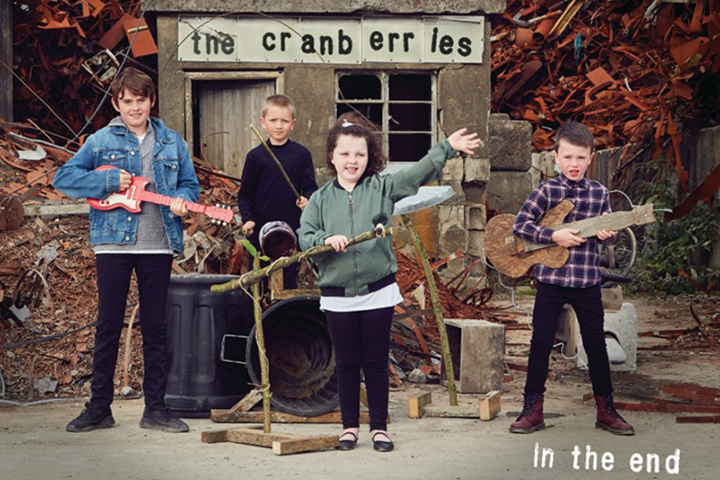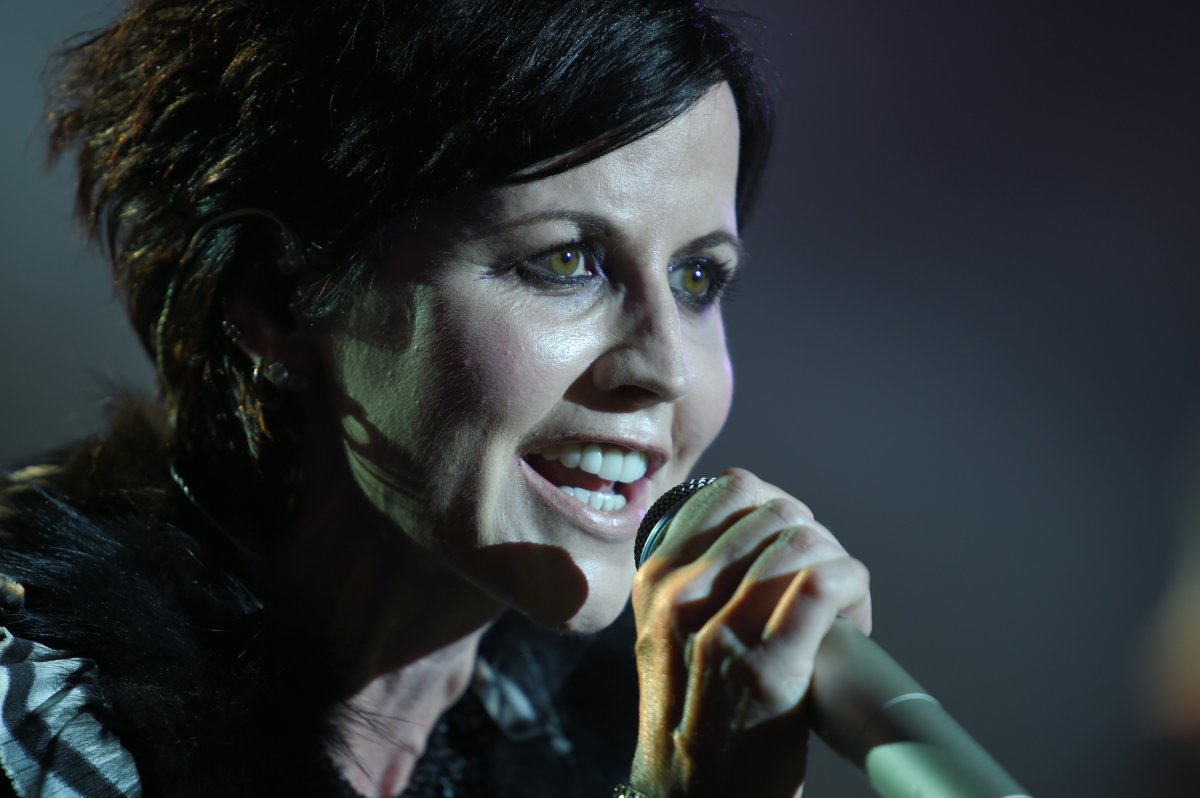After 30 years in the industry and the death of its frontwoman, The Cranberries are calling it quits. However, the surviving members will be treating us all to one last album.

That’s right, the legendary Irish rock band — best known for hits such as Linger, Zombie and Dreams — is releasing its eighth and final album next week.
In the End — the album’s title — is a fitting one, given not only their extensive history and successful back-catalogue, but as a parting message to their fans.
The band’s remaining members and founders — lead guitarist Noel Hogan, bassist Mike Hogan and drummer Fergal Lawler — vowed to finish the album after being set back by the tragic passing of their beloved leading lady and closest friend, Dolores O’Riordan.
Not only was she one of the most iconic voices in rock during the 1990s, but a figurehead and trailblazer for many young women and aspiring musicians across the globe.
READ MORE: The Cranberries share final music with Dolores O’Riordan
O’Riordan died in January 2018 at the age of 46. Fortunately for fans, she had recorded an entire album’s worth of vocals back in late 2017 in her New York City apartment.
Thanks to their songwriting capabilities and English producer Stephen Street, The Cranberries will deliver O’Riordan’s parting gift in complete to the band’s longtime fans — one they hope will serve as both a worthy goodbye and a fitting tribute to the late legend.
Global News caught up with band members Hogan and Lawler at Corus Quay in Toronto this week.
They filled us in about their time in the studio during the In the End sessions, the often forgotten history of The Cranberries, meeting passionate fans and overall how The Cranberries have been adjusting to life without O’Riordan.
READ MORE: Streaming music is worse for the environment than CDs, vinyl: study
Global News: Did you ever think music would take you as far as it has?
Noel Hogan: No, definitely not. It was a hobby. We loved music and there was a really healthy scene of local bands in Limerick, when we started around 1989. We started to notice that when we went to gigs that you’d know the guys in each band, so we thought “why can’t we do that?” and that’s really where it all began.
We met Dolores maybe a year later and we’d rehearse a couple of times a week and then started doing local shows. We were really young too, we were just kids, so we didn’t think too far ahead really. Suddenly, we’re 30 years on and we’ve got a very successful career behind us.
Fergal Lawler: We had a guy called Niall Quinn, who was singing for us briefly. He was in another band called The Hitchers, as their drummer, and he was writing songs that he wanted to do with a different band though — so he joined us. His songs were all intended to be a joke though. They were all kind of tongue-in-cheek funny, but we weren’t really into it. So after six months we were relieved to hear he was going back to The Hitchers full-time to concentrate on other things. We thought, “OK, great.” [Laughs] But through Niall, we met Dolores, because his girlfriend at the time was in school with her. She told Dolores, “Look, these guys are looking for a band, so…”
So was it when she joined that everything kind of fell in place?
NH: Well we were actually doing instrumentals for about six months after Niall left; wondering how we were going to keep it up without a singer. We found guys who looked fit for the part, but they just couldn’t sing. When we met Dolores we actually began to write songs and they started to come together pretty quickly, but still, none of us ever really visualized that we’d become as big as we had. We weren’t an arrogant band that expected or even thought that we’d get massive. As time went on and record companies started to come see us, we thought “maybe we can do something with this.”
WATCH: The Cranberries’ animated music video for lead single, ‘All Over Now’
READ MORE: Dolores O’Riordan memorial: Thousands gather to mourn The Cranberries’ singer

Get breaking National news
Every Cranberries album sounds so distinctly unique, but there’s something very reminiscent of the first album here. What are your thoughts on that?
FL: It’s something we definitely noticed with Dolores’ vocals. They were quite delicate, so we worked around that in the studio. She recorded these back in her New York apartment though, which is why I think she wasn’t belting it out for a lot of the songs. That was how she did it on the first couple of albums, so it definitely lends that old kind of feel. The big difference is that this is 30 years later and we’re definitely not the same musicians we were back then. There’s a bit more maturity involved now, so it’s like a nice mix of the two.
When did you start writing In the End? It’s been a long time coming it seems.
NH: It was a couple of years ago. We started in 2017. We had been on tour, but Dolores had this bad back injury that had been coming and going for about a year, so we had to work the tour around that. Eventually, the doctors had said to her, “It’s just not going to get better if you don’t rest it.” We weren’t expecting it, but we had to take six months off so that she could recover. So it was actually Dolores who suggested we start writing during the time off that we weren’t able to tour. We had already been talking about writing a new album while we were on tour anyway, so a fair share of it was done between June and December. But there had been other tracks that Dolores had been working on by herself prior to that too. So In the End is a mix of all of those demos really.
NH: They were written and the backbone was definitely there, they just needed to be played better, because demos are demos. [Laughs] Thankfully the vocal demos were already really strong, which is what we ended up with. We knew what the songs were going to be in terms of structure; verses, intros and so on, all we really needed to do was make them Cranberries songs.
I actually had a hard drive with everything Dolores sent me on it, but there were quite a few bits that I still didn’t have — which I knew were on one of her hard drives in New York. Fortunately, her partner brought that over for us so we could get what we needed and exactly what was missing.
FL: The first few days were very emotional, but the way we normally work in the studio has always been kind of like that. Dolores would do a day or so and put down around three tracks to a click track before heading off, because she didn’t want to be hearing songs again over and over. She felt that she’d lose her passion for it. The three of us would continue to work with Steve [Street] for a few days before Dolores came back in. In that respect, it was kind of a similar way of working, it’s just that when the evening time came… there was no Dolores coming back in.
READ MORE: Dolores O’Riordan called the Kawarthas home for nearly 20 years
NH: It was great actually! Once we got past the initial strangeness of it — on the first day particularly — it felt like just riding a bike, and that was the great thing about working with Steve, which is why we rang him up and asked him to do it. We have a good working relationship, but we’re also just really good friends. It wasn’t all doom and gloom either, [laughs] there was the usual messing about and joking around too. A few hours into the day, you kind of realize that everything’s working and then you get a bit more relaxed.
But Steve always hears more of it than we do, because you’re so involved in it, that it can be hard to see the wood from the trees. So, for us, he’s great for giving us a direction and getting the sound that we’ve been hoping to accomplish but aren’t quite sure how to execute it. When it came to treating Dolores’ vocals, he’d work so closely with her in all those years. We’d normally head off in the evening and they’d begin that process, so he knew what it was that she wanted or didn’t want. That’s actually one of the biggest reasons why we brought him in again.
You said that it wasn’t all “doom and gloom” in the studio, and I think many people are under the impression that In the End might embody some very sad or somber emotions. But that’s not entirely the case is it?
FL: No. I mean… all of The Cranberries albums have some sort of variation, because the songs are written from emotional standpoints, so you can be up or down, happy one day, or sad the next. It’s the same with this one: there’s a nice mix of upbeat songs and summery songs, and it’s nice to have that variation. I think it’ll surprise people.
Because this is your last album, I feel like the title says a lot, as well as the first single, All Over Now. Is this a recurring theme in the music?
NH: There’s no theme really. A lot of the songs actually already had titles, however, In the End didn’t. When you listen to it, it was obvious what the title meant. We recorded that on the very last day of us three being in the studio together. It was weird because the lyric is very much about things ending, what you thought they were, what they weren’t and how the grass is always greener, y’know, that sort of scenario. We recorded it and we knew that was the end of our process together as The Cranberries. It’s a very moving track and without even doing a double take we agreed that it would be a great title for the album. We were calling it In the End even before it became the official name of the track, so in that sense, it seemed very apt to end it all right there.
READ MORE: Celebrities we lost in 2018
FL: That was a bit of a conundrum at first, but the guy who came up with our first few album covers actually reached out to [record company] BMG. He heard were working on another album and he wanted to be involved, so he brought us this one as his first idea. He said, “maybe we can get kids that are related to you in some way and put them on the cover.” We didn’t want to use old material because it’s new music, so you don’t want to release it with older images, it just wouldn’t make sense. We loved the idea right away. It was a perfect idea, we just thought, “thank God.”
NH: Yeah this was perfect. It’s cool because it represents us as kids in one way while also the passing of the torch onto the next sort of generation too.
Is it correct that you got the blessings from Dolores’ family to finish the album. Have they heard it?
FL: Yeah, her Mum hasn’t listened to it. She felt that she’s not ready for it yet, but her brothers and sister listened to it and they loved it. They kinda said she’d be really proud and even relieved to hear that.
NH: We’re definitely getting more used to the idea, but a year is nothing really. I think having this project has been a good distraction for the three of us, because it really wasn’t that long after Dolores passed that we went in to start recording — it’s actually it’s a year tomorrow [April 16]. We wonder now how we would have dealt with the last 12 months if we hadn’t have done this and instead just said, “Oh, we’ll wait ‘til next year before we do this album.” But we’re musicians and we’ve been doing this since we were kids, so what else would we do? It’s just a natural draw that you want to do that. I don’t think the album would sound the way it does now if we did it later either, because we wouldn’t have been as wound up about it all by then. I think musically, that comes across in a weird kind of way on this album. It’s kept us really busy and there hasn’t really been time to think about anything else in the last year.
It still feels surreal if you sit down and start thinking about it too much. It feels like it’s just a dream in some ways, but I think we’re doing okay.
READ MORE: The best moments in Canadian music of 2018
In the End wasn’t just a distraction for you guys though. You’ve said it before, but it’s ultimately for the fans, right?
FL: It’s like a gift. She left them this gift… and it was really sweet of her.
NH: I think most of all it’s for them. There was this massive outpouring when she passed away and nobody expected it. Many people assumed that that would be the end for us, and if there was going to be this overwhelming kind of “no” after announcing that we were going to do the album, then we might have just said “maybe not.” Fortunately, it was nothing but positive. Even though we hadn’t gone into the studio before it happened, we had already started writing the album. So that process had begun. We were really, in many ways, just finishing the job.
Since January, when we started the promo tour, we’ve met so many fans who just can’t wait to hear it. It’s a bit of a bittersweet thing obviously, because when it’s out there… well, it’s out there, it’s done and everything is finished. But, isn’t it better to have this than everything just ending suddenly a year ago?
—
READ MORE: Remembering Dolores O’Riordan, the tiny Irish woman with a big, big voice
The Cranberries were among the handful of female-fronted bands and the fact that their music still plays on the radio today is truly a testament to what they did to the music scene.
This album marks not only the band’s final release, but also the end of The Cranberries’ altogether. Once the album’s out, The band will conclude their three-decade career.
In the End will be released on April 26 under the BMG label and can be pre-ordered through The Cranberries’ official website.
In The End tracklist
- All Over Now
- Lost
- Wake Me When it’s Over
- A Place I Know
- Catch Me if You Can
- Got it
- Illusion
- Crazy Heart
- Summer Song
- The Pressure
- In the End














Comments